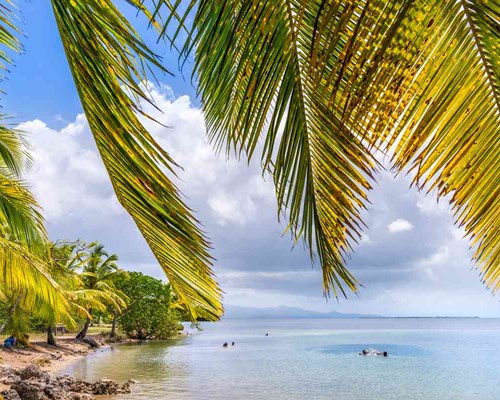With a mix of beautiful tranquil beaches, turquoise lagoons, a vibrant underwater world and a rich heritage, Grande Terre makes a wonderful Caribbean holiday destination. Beyond the scenery, there is a fascinating history and a melting pot of culture. Music, dance, art and cuisine has influence from France, Africa, India and neighbouring Caribbean countries. Grande Terre has much to offer in the form of unforgettable landscapes, natural attractions and great cuisine to explore and discover.
Popular attractions & excursions in Grande Terre

Musée Schoelcher, Pointe-à-Pitre
Victor Schoelcher famously contributed to the freedom of slaves in the French colonies and was also a keen collector of art and antiques – this museum gives visitors a glance at both sides of Schoelcher, in a beautifully kept Victorian house next to the city hall in Pointe-à-Pitre.

Mémorial ACTe, Pointe-à-Pitre
A centre dedicated to the expression and memory of slavery and the slave trade. Telling the history of slavery through documents, photos, artefacts and audio testimonials. The exhibition space shows different exhibits throughout the year, while the panoramic gardens are the perfect place to sit down with an ice cream and take it all in.

Cathédrale de St-Pierre et St-Paul, Pointe-à-Pitre
Known as the ‘Iron Cathedral’ after its hurricane-resistant iron structure, this colonial style cathedral is beautiful from the outside and even more stunning inside.

Fort Fleur d’Epee, Gosier
If you have a free half hour or so in Gosier, head over to this 18th century fort – if only for the glorious views over the bay. Often art exhibitions are held in the underground tunnels. Kids will love running around.

Aquarium de la Guadeloupe, Gosier
On the marina, the aquarium lets visitors get up close to all manner of Guadeloupian flora and fauna (corals, sharks, turtles…) without needing to scuba dive. They also run catamaran and snorkel excursions from here.

Morne-à-l'Eau cemetery
Morne-à-l'Eau cemetery is an eye-catching hillside cemetery in the heart of Grande Terre island. Most of the crypts are decorated with stunning checkered black and white. This is one of the most visited cemeteries in Guadeloupe... it's not hard to see why!

Damoiseau Rum Distillery, Moule
Find out about the history and production of rum, see the machinery in action and taste samples. There’s a lovely garden, as well as a shop where you can buy bottles of rum and souvenirs.

Beauport, Port Louis
A refurbed old sugar factory in the heart of Guadeloupe’s sugar cane country in Port Louis. The Beauport Site tells of the history and culture of sugar cane production. Pass abandoned machinery, mills and take a train ride through cane fields. There’s a nice picnic area and a playground for little ‘uns.

Pointe des Chateaux, Saint-François
11km out of St François town, the ‘Point of the Castles’ is one of (if not THE) most visited spots in Guadeloupe. Contrary to the name, there are no castles to be seen, but instead the end of a rugged, cliffy peninsular brimming with natural beauty. It was named a ‘Grand Site de France’ for its biodiversity and archaeological finds. From Pointe des Colibris at the tip, the view over the island’s peninsula and nearby islands of La Desirade, Petit Terre and Marie Galante is spectacular. If you time your visit right (springtime is best), you might spot some whales.

Mud baths, Vieux-Bourg
Babin beach is a bit different from the other beaches in Guadeloupe. Don’t get us wrong, it’s still beautiful - but rather than sparkling white sand beneath clear blue waters, instead you’ve got mud, glorious mud. And not just any old mud, these clay sediments are known throughout the land for their healing properties. Swim 10-20 metres off the shore, scoop up a dollop of the good stuff and slather it all over – or do like the local and bring a tub for take-home-mud-therapy.

Petite-Terre Islands
Get an eyeful of Guadeloupian wildlife on a boat trip to the diddy isle of Terre-de-Bas. It takes about three quarters of an hour to reach on boat from Saint-François, and once you’ve arrived you can dive amongst turtles, fish and small sharks or spot iguanas and lizards inland. The lighthouse at ‘world’s end’ has a museum about flora and fauna. Last time we checked, the other island in this duo – Terre-de-Haut – didn’t have public access.

Grand Cul-de-Sac Marin
An enormous lagoon off the west coast of Grande-Terre, the bulk of which has been made a UNESCO Biosphere Reserve to preserve the coral reef, forest, mangrove, marshes and islets that make up this brilliantly biodiverse part of the world. Animal lovers will find birds, turtles, hundreds of species of fish. It’s possible to book kayak and boat trips through the lagoon.

Ilet du Gosier
Swim from the shore or pack a picnic and get a fishing boat to take you over to the Ilet. There’s a marked snorkelling route. Come at the right time (morning, low season is best) and you might just have the white sand shores of this gorgeously diddy island (complete with lighthouse) to yourself.

Basse Terre
Experience the wildly different landscape of next-door-neighbour island Basse Terre, which can be reached on road via the bridge that connects the islands. Head deep into the rainforest to explore waterfalls and hike up the Soufriere volcano. Soak in hot natural pools, visit the zoo or get an eyeful of the seaside towns and villages.


